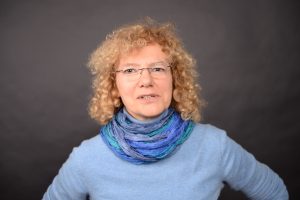Name: Prof. Dr. Susanne Heise
Telefon: +49-40-428 75-6217
Email: susanne.heise(at)haw-hamburg.de
Position: Head of working group
Background and Interests
Susanne Heise studied biology at the universities of Bielefeld, Edinburgh (GB) and Kiel. She did her PhD in biological oceanography at the Institute for Baltic Sea Research (today IFM-Geomar) and worked as a Postdoc at the Technical University Hamburg-Harburg (Departments of Marine Technology and of Environmental Protection) and at the Institute for Baltic Sea Research in Warnemünde where she studied the impact of environmental contaminants on bacterial exopolymer production in sediments. During this time, she went on two short-term lectureships, funded by the German Academic Exchange Service (DAAD), to the Illigan Institute of Technology, Philippines, to teach marine microbiology.
After her post-doc time, she became project manager of the Consulting Centre for Integrated Sediment Management at the TU Technical Innovation for 6 years.
Susanne Heise was founding member of the consulting company CRM (www.crm-online.de) and of the European Sediment Network „SedNet“ (www.sednet.org). For SedNet, she coordinated the work group on „Sediment Risk Management and Communication“ for 3 years. She also started the Sediment Advisory Group as a joined initiative of SedNet and SETAC, and was on the editorial board of the SETAC journal „International Environmental Assessment and Management“.
Today she is member of the SedNet Steer Group.
Since 2008, Susanne Heise is Professor at the Hamburg University of Applied Science (www.haw-hamburg.de) and teaches cell- and microbiology, chemical safety, ecotoxicology and environmental assessment. She is head of the research group of Applied Aquatic Toxicology.
Within the field of aquatic toxicology, she is interested in the effects that environmental contaminants have on the aquatic community, with a strong focus on sediments.
Current research projects:
- Blue Estuaries – Nachhaltige Ästuar-Entwicklung unter Klimawandel und anderen Stressoren
- Panorama – H2020 – International Training Networks
- TOxAR – Toxic Alarm with AR-Assistance Under Water
- MANTICC
- Sullied Sediments
12 selected publications (alle)
Ahlf W., Drost W. & Heise S. (2009). Incorporation of metal bioavailability into regulatory frameworks—metal exposure in water and sediment. Journal of Soils and Sediments, 9, 411-419.
Angelstorf, J.S., Ahlf, W., von der Kammer, F., and Heise, S. (2014). Impact of particle size and light exposure on the effects of TiO2 nanoparticles on Caenorhabditis elegans. Environmental Toxicology and Chemistry 33, 2288-2296.
Brack W., Apitz S.E., Borchardt D., Brils J., Cardoso A.C., Foekema E.M., Gils J.v., Jansen S., Harris B., Hein M., Heise S., Hellsten S., Maagd P.G.-J.d., Müller D., Panov V.E., Posthuma L., Quevauviller P., Verdonscho P.F. & Ohe P.C.v.d. (2009). Toward a holistic and risk-based management of european river basins. Integrated Environmental Assessment and Management, 5, 5-10.
Heise S. (ed.) (2007). Sediment Risk Management and Communication. Elsevier, Amsterdam.
Heise S. & Förstner U. (2007). Sedimente und WRRL – Fallstudien Rhein und Elbe. In: Ingenieurgeochemie (eds. Förstner U & Grathwohl P). Springer Berlin, pp. 361-392.Heise S., Krüger F., Baborowski M., Stachel B., Götz R. & Förstner U. (2008). Bewertung der Risiken durch Feststoffgebundene Schadstoffe im Elbeeinzugsgebiet. Im Auftrag der Flussgebietsgemeinschaft Elbe und Hamburg Port Authority Hamburg, p. 349.
Heise, S. (2015). Zur Belastung von Sedimenten mit Spurenmetallen und historischen, organischen Schadstoffen in Altarmen der Elbe. HyWa 59, 332-341.
Herrmann, H., Nolde, J., Berger, S., and Heise, S. (2016). Aquatic ecotoxicity of lanthanum – A review and an attempt to derive water and sediment quality criteria. Ecotoxicology and Environmental Safety 124, 213-238.
Lillebø, A.I., Somma, F., Norén, K., Gonçalves, J., Alves, M.F., Ballarini, E., Bentes, L., Bielecka, M., Chubarenko, B.V., Heise, S., et al. (2016). Assessment of marine ecosystem services indicators: Experiences and lessons learned from 14 European case studies. Integrated Environmental Assessment and Management 12, 726-734.
Kowalevska G., Belzunce-Segarra M.J., Schubert B., Heininger P. & Heise S. (2011). The role of sediments in coastal monitoring. In: Chemical Marine Monitoring: Policy Framework and Analytical Trends (eds. Quevauviller P, Roose P & Verreet G). John Wiley and sons., pp. 377-395.
Liehr G., Heise S., Ahlf W., Offermann K. & Witt G. (2013). Assessing the risk of a 50-year-old dump site in the Baltic Sea by combining chemical analysis, bioaccumulation, and ecotoxicity. Journal of Soils and Sediments 13 (7), 1270-1283
Suciu N., Capri E., Trevisan M., Tien H., Heise S., Schuhmacher M., Nadal M., J. Rovira, Seguí X., Casal J. & Darbra R.M. (2013). Human and Environmental impact produced by E-waste releases at Guiyu Region (China). In: Global Risk-Based Management of Chemical Additives, Volume II. Risk based assessment and management strategies, Handbook of Environmental Chemistry (eds. Bilitewski B, Darbra R & Barcelo D). Springer, pp. 349-384.

